Chip Seal VS Asphalt – What’s Best for Your Driveway?
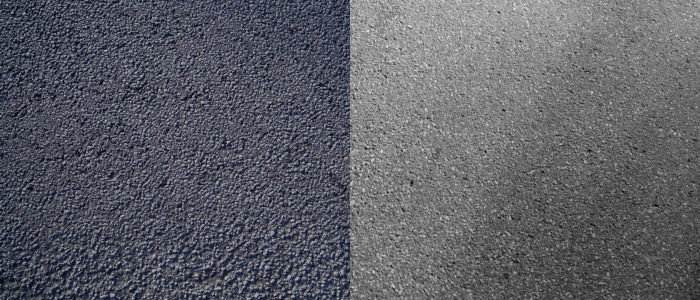
When it comes to resurfacing, the debate of chip seal vs asphalt is common. Each method serves different needs, understanding their strengths helps you make the right paving decision.
Chip seal is a surface treatment that layers liquid asphalt with crushed stone, offering a quick, cost-effective finish ideal for low-traffic areas. Asphalt paving is a thicker, smoother surface made from hot-mix asphalt, designed for durability and high-traffic use. While chip seal is more affordable and faster to install, asphalt lasts longer and looks sleeker. The right choice depends on your budget, usage needs, and long-term maintenance plans.
Read on as we compare installation, cost, durability, and maintenance to help you choose the best paving option for your home or commercial property.
Chip Seal vs Asphalt – Overview
Understanding the key differences between chip seal and asphalt helps you choose the best surface treatment. Here’s a breakdown of how each option works, plus pros and cons.
What Is a Chip Seal?
Chip seal is a pavement surface treatment that combines hot liquid asphalt with a layer of crushed stone. Applied over existing pavement or compacted base, it’s ideal for rural roads, driveways, or areas needing improved traction. Chip seal is valued for its affordability and speed of application, projects are often completed within a day.
- Pros: It costs up to 50% less than asphalt, offers excellent skid resistance, and uses fewer raw materials, often incorporating recycled stone.
- Cons: The surface is rougher and noisier, loose stones may appear initially, and its lifespan is shorter, typically 7–10 years, making it best for lower-traffic applications.
What Is Asphalt Pavement?
Asphalt pavement, commonly used for roads and driveways, is made by combining hot asphalt cement with aggregates like sand and gravel. This mixture is laid in thick layers and compacted to form a smooth, durable surface. It’s designed to handle heavy loads and high traffic over long periods.
- Pros: Asphalt offers a sleek, uniform appearance, superior durability (15–20 years), and quieter performance under traffic. It’s well-suited for residential and commercial use.
- Cons: It requires a higher initial investment, takes longer to install and cure, and needs routine sealcoating every 3–5 years to maintain its integrity and prevent cracking.
What Are They & How They’re Installed
When deciding between chip seal vs asphalt, it’s crucial to understand how each is installed. The construction process influences not only the appearance and longevity of the surface, but also its suitability for different traffic loads and environments. Both methods create durable paved surfaces, but the materials, time, and techniques involved differ significantly. Here’s a detailed look at how each one is installed, and what makes them distinct.
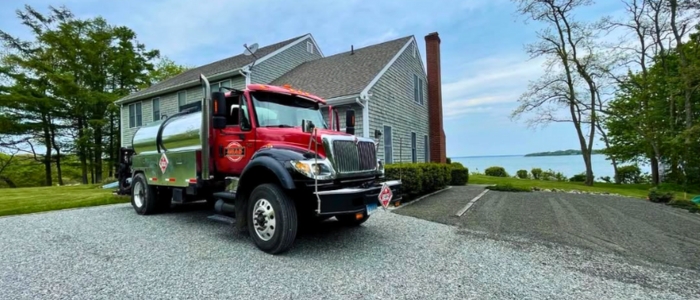
Chip Seal Installation: A Surface Refresh
Chip seal is often used as a maintenance treatment or cost-effective paving option. Think of chip seal like a quick refresh, it rejuvenates worn pavement without a full structural overhaul.
Step-by-Step Process:
- Surface Preparation
Existing pavement is cleaned and any cracks or potholes are filled. A clean, dry base is essential for proper adhesion. - Binder Application
Hot liquid asphalt emulsion is sprayed evenly across the surface. This acts as the adhesive layer that will hold the aggregate in place. - Aggregate Spreading
Crushed stone or gravel (usually ¼ inch in size) is spread immediately over the hot binder using a chip spreader. The type of stone can be chosen to match aesthetic or performance needs. - Compaction
Rollers are used to embed the stone into the asphalt layer, enhancing durability and reducing loose material. - Sweeping and Optional Fog Seal
After compaction, the surface may be swept to remove excess stones. Some installations include a fog seal, a light application of asphalt emulsion over the top for added sealing and dust control.
Unlike asphalt, chip seal does not add new structural thickness to a surface, it’s mainly a top-layer treatment. It’s ideal for driveways, rural roads, and low-traffic areas where quick installation, traction, and cost-savings are priorities.
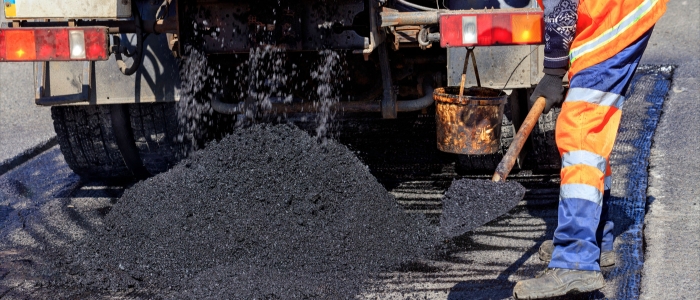
Asphalt Paving: A Full Structural Makeover
Asphalt paving is more robust and suited for areas with heavier traffic or structural needs. Think of it as a full makeover, it builds a new surface from the base up.
Step-by-Step Process:
- Grading and Base Preparation
A solid sub-base is graded and compacted. This layer supports the asphalt and ensures proper drainage. - Binder Layer Application
In multi-layer installations, a binder layer (a mix of larger aggregates and asphalt) is applied for strength and flexibility. - Surface Layer Application
The top layer is a finer hot-mix asphalt that provides a smooth, uniform finish. It’s poured and spread while hot. - Compaction
Heavy rollers compact each layer to remove air pockets and improve bonding, which increases the pavement’s durability. - Curing and Sealcoating
Asphalt must cure for 24–72 hours. Over time, sealcoating is applied (every 3–5 years) to protect against UV rays, water, and oxidation.
Asphalt is more time-consuming and costly upfront than chip seal but delivers a longer-lasting, high-performance surface ideal for driveways, parking lots, and roads that endure significant traffic.
Curious which option is right for your driveway? Let our experts help you make the best choice for your needs and budget. Contact us today.
Thinking About a New Chip Seal Driveway?
Request a Free Quote
Our team is ready to help you create a durable, beautiful surface that stands the test of time. Contact us today to learn more.
Cost Comparison
When choosing between chip seal vs asphalt, cost is often a deciding factor. While both offer strong performance in the right conditions, their price points, both upfront and over time, vary significantly. Understanding these cost dynamics helps property owners make informed choices that align with their budget and long-term goals.
Initial Cost Differences
Chip seal is generally 25–40% cheaper than asphalt on installation. This makes it an attractive option for large areas like long rural driveways, private roads, and low-traffic parking lots where budget is a primary concern. Asphalt, while more expensive, provides a smoother, more durable surface suited to higher traffic volumes.
| Surface Type | Average Installation Cost (per sq. ft.) | Relative Cost Comparison |
| Chip Seal | $1.50 – $3.00 | 25–40% less expensive |
| Asphalt Paving | $3.00 – $7.00 | Higher initial investment |
Note: Prices vary by location, materials, and prep needs.
Short-Term vs. Long-Term Investment
In the short term, chip seal is the budget-friendly option, especially for surfaces that don’t require structural reinforcement. It installs faster, is less labor-intensive, and requires fewer materials, contributing to immediate savings.
However, chip seal typically lasts 7–10 years, while asphalt can endure 15–20 years with proper maintenance. Over time, the need for more frequent chip seal reapplications can diminish its initial savings. Asphalt, on the other hand, may deliver a stronger return on investment (ROI) for those prioritizing longevity and minimal disruption.
Maintenance Cycles & ROI
Maintenance frequency also plays into total lifecycle cost:
- Chip Seal: Reapply every 7–10 years; sweeping and minor repairs required.
- Asphalt: Requires sealcoating every 3–5 years, with potential overlays around 10–12 years.
While asphalt’s maintenance is more structured and potentially costlier, its longer lifespan and structural strength mean fewer total resurfacing projects over time. This makes asphalt a better long-term investment for high-traffic driveways or commercial use.
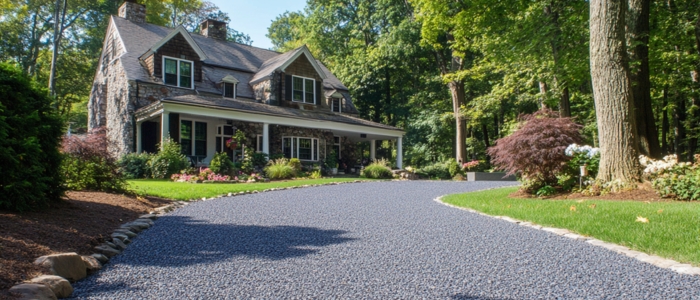
Durability & Lifespan
The durability and lifespan of a pavement surface depend heavily on the materials used and the environmental conditions it faces. Chip seal surfaces typically last 5–10 years, or up to 15 years in low-traffic settings with proper maintenance. Asphalt surfaces, by contrast, last 15–20 years, especially when sealcoated every few years to protect against weathering.
Wear and tear on both surfaces are caused by several common factors:
- UV exposure, which can dry and crack the surface
- Freeze-thaw cycles, leading to expansion and contraction
- Heavy traffic, which stresses the surface and can cause ruts or cracks
- Poor drainage, which accelerates deterioration
While chip seal offers good weather resistance and skid protection, its thinner profile makes it more vulnerable to wear under stress. Asphalt’s thicker, compacted layers give it better load-bearing strength and a longer functional life in demanding environments.
Best Use Cases (Traffic & Application)
Selecting between chip seal vs asphalt depends greatly on where and how the surface will be used. Each option has strengths tailored to specific environments and usage demands.
Rural Settings
Chip seal is an excellent fit for rural roads, long driveways, and agricultural areas. It blends well with natural surroundings, provides good traction, and is budget-friendly for covering large surfaces. Because traffic is generally light, the shorter lifespan poses minimal risk, especially when reapplied on schedule.
Residential Areas
For standard driveways or neighborhood streets, both chip seal and asphalt are viable. Chip seal suits long or shared driveways where cost savings are important. Asphalt, however, is preferred for homes in urban or suburban neighborhoods where aesthetics and durability under daily vehicle use are key.
Commercial Properties
Asphalt is the clear choice for commercial lots, loading zones, and roadways that see heavy or consistent traffic. Its structural strength and longer lifespan reduce maintenance disruptions and long-term costs. Chip seal is not recommended here due to its limited load-bearing capacity and risk of early degradation under stress.
Ultimately, selecting the right material requires assessing traffic load, environment, and long-term usage expectations.
Need help choosing the right surface for your property? Talk to the experts now for tailored guidance and a free quote.
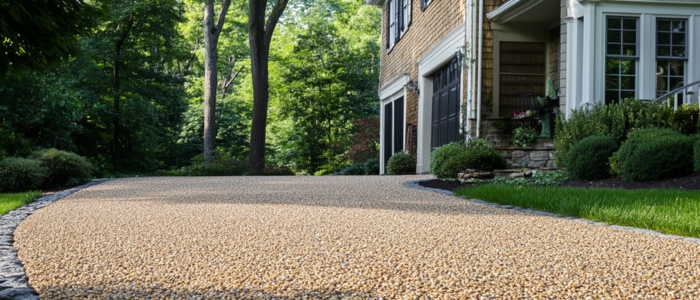
Surface Qualities
The surface qualities of chip seal vs asphalt play a significant role in how the pavement looks, feels, and performs. These qualities affect not only the aesthetic appeal but also safety and user experience.
- Texture: Chip seal has a coarse, stone-embedded texture that provides a natural, rustic appearance. This surface is excellent for traction but may feel rougher underfoot or for cyclists. Asphalt, on the other hand, offers a smooth and uniform finish, ideal for urban settings and comfortable driving.
- Noise: Because of its uneven texture, chip seals tend to be louder under tires, especially at higher speeds. Asphalt’s smoother finish produces significantly less road noise, making it preferable for residential or commercial areas where quiet is a priority.
- Skid Resistance: Chip seal is highly skid-resistant due to its textured surface, making it a safer option in wet or snowy conditions. Asphalt provides moderate skid resistance but can become slick if not properly maintained.
- Appearance: Chip seal offers customizable stone colors for a more natural, varied look. Asphalt delivers a classic, blacktop appearance that fades over time without sealcoating.
| Quality | Chip Seal | Asphalt |
| Texture | Coarse, stone-textured | Smooth and uniform |
| Noise | Louder | Quieter |
| Skid Resistance | High | Moderate |
| Appearance | Rustic, customizable | Clean, classic blacktop |
Each surface has distinct benefits, your choice should reflect both aesthetic goals and functional needs.
Climate & Weather Resilience
Climate plays a critical role in how well chip seal vs asphalt perform over time. Chip seal is known for handling extreme heat effectively, its light-colored aggregate reflects sunlight, keeping the surface cooler and reducing heat-related damage. It also performs well in wet or snowy conditions, offering excellent drainage and skid resistance due to its textured surface. However, repeated freeze-thaw cycles can loosen aggregate and accelerate wear.
Asphalt, while more heat-absorbent, is engineered to expand and contract with temperature changes. In hot weather, it may soften slightly; in colder climates, it risks cracking if not properly sealed. Drainage is crucial, without proper grading, water can pool and seep into cracks, leading to further damage.
Both surfaces can perform well in varying climates, but chip seal is often better for regions with high heat and precipitation, while asphalt is ideal when maintained in freeze-prone environments with regular sealcoating.
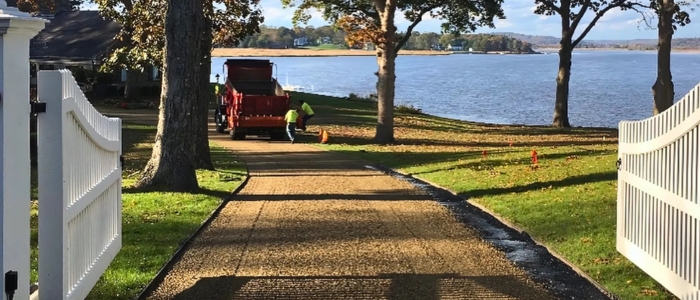
Maintenance & Repairs
Maintenance is essential for extending the life of chip seal vs asphalt surfaces, but the type and frequency of upkeep differ significantly between the two paving methods.
Chip Seal Maintenance:
- Reapplication: Typically every 7–10 years to restore texture and seal cracks.
- Sweeping: Required shortly after installation to remove loose aggregate.
- Minor Repairs: Cracks and surface wear can often be addressed with spot treatments or localized chip applications.
Asphalt Maintenance:
- Sealcoating: Recommended every 3–5 years to protect from UV damage, water infiltration, and oxidation.
- Overlays: Applied every 10–12 years as a cost-effective resurfacing option without full replacement.
- Crack Filling & Patching: Needed more frequently, especially in colder climates where freeze-thaw cycles are common.
In terms of repair costs and ease, chip seals are generally simpler and cheaper to refresh. The process involves fewer materials and can often be completed in less time.
Asphalt repairs, while more involved, can handle deeper structural issues, making them better for heavily used surfaces.
Regular upkeep ensures both options remain safe, attractive, and functional, but asphalt may offer a longer maintenance cycle with a higher upfront investment.
Environmental Factors
Both chip seal and asphalt have environmental implications worth considering, particularly in terms of materials, energy use, and sustainability. Chip seals tend to be more eco-friendly due to its lower material consumption and ability to use recycled aggregate. It also reflects more sunlight, resulting in less heat absorption, which can help mitigate urban heat island effects.
In contrast, asphalt absorbs and retains more heat because of its dark surface, potentially raising local temperatures. However, modern asphalt is highly recyclable, and reclaimed asphalt pavement (RAP) is frequently reused in new paving projects.
From an application standpoint, chip seal vs asphalt shows a clear difference in environmental impact. Chip seal has a lower energy footprint, requiring less heating and fewer resources during installation. Asphalt, especially hot-mix, demands higher temperatures and heavier machinery, leading to increased fuel use and emissions. For projects prioritizing sustainability, chip seal often presents the more eco-friendly option, especially in areas with moderate traffic demands.
FAQs
Yes, chip seals can be applied over existing asphalt as long as the base surface is structurally sound. Cracks and potholes should be repaired beforehand to ensure proper adhesion and durability. This makes chip seal a cost-effective way to rejuvenate aged asphalt without complete replacement.
Chip seal surfaces are typically drivable within a few hours after installation. However, full curing may take 24 to 48 hours, depending on weather conditions. It’s recommended to avoid sharp turns and high speeds during the first few days to allow the aggregate to set fully.
In the short term, chip seal is significantly cheaper, often 25–40% less than asphalt. However, because chip seal needs to be reapplied every 7–10 years, while asphalt can last 15–20 years with proper maintenance, asphalt may offer better long-term value in high-traffic areas. The more cost-effective choice depends on usage, maintenance, and longevity needs.
Thinking About a New Chip Seal Driveway?
Request a Free Quote
Our team is ready to help you create a durable, beautiful surface that stands the test of time. Contact us today to learn more.
Conclusion
Choosing between chip seal vs asphalt ultimately depends on your project’s priorities, whether that’s cost, durability, appearance, or environmental impact. Chip seal stands out for its affordability, quick installation, and excellent skid resistance, making it ideal for rural roads, long driveways, and low-traffic areas. Asphalt, on the other hand, delivers a longer-lasting, smoother, and structurally stronger surface, better suited for urban, residential, or commercial use.
This comparison highlights that neither surface is one-size-fits-all. By weighing factors like climate, maintenance needs, traffic volume, and aesthetic preferences, you can confidently select the best solution for your pavement.
At New England Asphalt Services, we specialize in both chip seal and asphalt paving, offering expert guidance tailored to your needs. Contact us today for a personalized consultation and free estimate.



